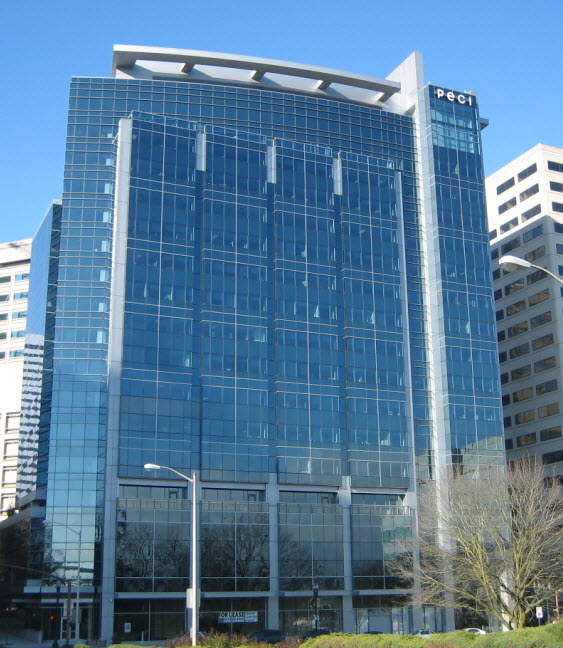New Buildings Institute (NBI) has developed the first ever set of plug load energy use metrics, which will allow commercial building owners and managers to more easily gain insight into their buildings’ energy use and become more energy efficient. Earlier this year, PECI used the NBI metrics to assess plug load energy use at PECI headquarters in the First and Main building in downtown Portland, Oregon. The study, which informed an energy-saving campaign, resulted in an 18 percent kWh reduction of PECI’s plug load.
Review New Buildings Institute Metrics, “Methodology for Reporting Commercial Office Plug Load Energy Use” and PECI case study, “Analyzing Plug Loads.”
According to the Energy Information Agency, plug load – which is defined as electricity use by equipment that plugs into a building’s electrical outlets – is one of the fastest-growing sources of energy use in commercial buildings. In typical offices, 15 to 20 percent of energy use can be attributed to the plug load of computers, monitors, printers, desk lamps, telephones, etc. In buildings with HVAC and/or lighting systems that have been upgraded or improved to be more energy-efficient, plug load can reach as high as 50 percent of total energy use.
The intent of NBI’s new metrics is to set a benchmark for plug load energy use and make it easier for building owners and managers to spot opportunities to improve energy efficiency. The methodology allows an apples-to-apples comparison of plug load energy use across commercial buildings, even if they have vastly different plug load makeups and characteristics.
PECI helped NBI test the theories behind their metrics during a study conducted in the Portland offices of PECI. PECI’s LEED Platinum office is equipped with an energy management system that allows circuit-level monitoring of energy use throughout the office space. This fact, coupled with PECI’s commitment to the study, practice and influence of responsible energy management, made the site – and the pairing – ideal.
NBI’s metrics showed that PECI’s plug load performance during business hours was already quite good, with numbers comparable to the metrics’ lowest reference value. Overnight, however, PECI’s plug load rated more poorly, with values above the metrics’ median.
“We discovered our higher overnight plug load was primarily due to people leaving their computers in ‘sleep mode’ when they left the office for the day,” said Joan Effinger, Engineering Manager at PECI. “We were excited to use the findings as an opportunity to improve.” PECI launched an internal campaign to motivate people to completely shut off their computers at the end of the day, which contributed to an 18 percent kWh reduction of plug load.
“It was very valuable to conduct such a successful test in a real-world situation,” said Cathy Higgins, Research Director of NBI. “Hopefully this is the first of many cases when people use these new metrics to improve the performance of buildings and reduce energy and cost.”
[1] Plug loads are a part of what is known as Miscellaneous Electrical Loads (MELS)
About PECI
PECI is a nonprofit corporation dedicated to creating the new energy economy. We are leaders in the field of energy resource management, with expertise in designing and implementing energy efficiency programs for utility and government agency clients. Our work helps millions of residential, commercial and industrial utility customers reliably save energy and money. We were founded in 1979 in Portland, Oregon and currently work with clients nationwide. To learn more, visit www.peci.org.
About NBI
Established in 1997, New Buildings Institute (NBI) has been a driving force in advancing energy code stringency, most notably with the adoption of the 2012 International Energy Conservation Code (IECC), which was based largely on NBI's Core Performance Guide--a prescriptive approach to high performance commercial buildings. The organization also advocates for measuring building energy performance in occupancy rather than relying on modeled predictions to assess efficiency levels, and has become a clearinghouse on zero-net energy policies and practices. To learn more about NBI go towww.newbuildings.org or call 360.567.0950.
Related Stories
MFPRO+ News | May 20, 2024
Florida condo market roiled by structural safety standards law
A Florida law enacted after the Surfside condo tower collapse is causing turmoil in the condominium market. The law, which requires buildings to meet certain structural safety standards, is forcing condo associations to assess hefty fees to make repairs on older properties. In some cases, the cost per unit runs into six figures.
Office Buildings | May 20, 2024
10 spaces that are no longer optional to create a great workplace
Amenities are no longer optional. The new role of the office is not only a place to get work done, but to provide a mix of work experiences for employees.
Mass Timber | May 17, 2024
Charlotte's new multifamily mid-rise will feature exposed mass timber
Construction recently kicked off for Oxbow, a multifamily community in Charlotte’s The Mill District. The $97.8 million project, consisting of 389 rental units and 14,300 sf of commercial space, sits on 4.3 acres that formerly housed four commercial buildings. The street-level retail is designed for boutiques, coffee shops, and other neighborhood services.
Construction Costs | May 16, 2024
New download: BD+C's May 2024 Market Intelligence Report
Building Design+Construction's monthly Market Intelligence Report offers a snapshot of the health of the U.S. building construction industry, including the commercial, multifamily, institutional, and industrial building sectors. This report tracks the latest metrics related to construction spending, demand for design services, contractor backlogs, and material price trends.
K-12 Schools | May 15, 2024
A new Alabama high school supports hands-on, collaborative, and diverse learning
In Gulf Shores, a city on Alabama’s Gulf Coast, a new $137 million high school broke ground in late April and is expected to open in the fall of 2026. Designed by DLR Group and Goodwyn Mills Cawood, the 287,000-sf Gulf Shores High School will offer cutting-edge facilities and hands-on learning opportunities.
Adaptive Reuse | May 15, 2024
Modular adaptive reuse of parking structure grants future flexibility
The shift away from excessive parking requirements aligns with a broader movement, encouraging development of more sustainable and affordable housing.
Affordable Housing | May 14, 2024
Brooklyn's colorful new affordable housing project includes retail, public spaces
A new affordable housing development located in the fastest growing section of Brooklyn, N.Y., where over half the population lives below the poverty line, transformed a long vacant lot into a community asset. The Van Sinderen Plaza project consists of a newly constructed pair of seven-story buildings totaling 193,665 sf, including 130 affordable units.
K-12 Schools | May 13, 2024
S.M.A.R.T. campus combines 3 schools on one site
From the start of the design process for Santa Clara Unified School District’s new preK-12 campus, discussions moved beyond brick-and-mortar to focus on envisioning the future of education in Silicon Valley.
University Buildings | May 10, 2024
UNC Chapel Hill’s new medical education building offers seminar rooms and midsize classrooms—and notably, no lecture halls
The University of North Carolina at Chapel Hill has unveiled a new medical education building, Roper Hall. Designed by The S/L/A/M Collaborative (SLAM) and Flad Architects, the UNC School of Medicine’s new building intends to train new generations of physicians through dynamic and active modes of learning.
Sustainability | May 10, 2024
Perkins&Will’s first ESG report discloses operational performance data across key metrics
Perkins&Will recently released its first ESG report that discloses the firm’s operational performance data across key metrics and assesses its strengths and opportunities.

















